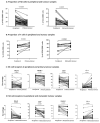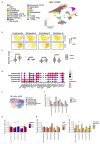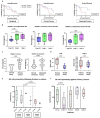The emergence of DNAM-1 as the facilitator of NK cell-mediated killing in ovarian cancer
- PMID: 39835114
- PMCID: PMC11743932
- DOI: 10.3389/fimmu.2024.1477781
The emergence of DNAM-1 as the facilitator of NK cell-mediated killing in ovarian cancer
Abstract
Introduction: Ovarian cancer (OC) is the sixth most common malignancy in women and the poor 5-year survival emphasises the need for novel therapies. NK cells play an important role in the control of malignant disease but the nature of tumour-infiltrating and peripheral NK cells in OC remains unclear.
Methods: Using flow cytometric analysis, we studied the phenotype and function of NK cells in blood, primary tumour and metastatic tissue in 80 women with OC. The cell type contexture of metastatic OC tissue was explored utilising scRNAseq analysis, with a focus on portraying an immunogenic tumour microenvironment and determining the characteristics of a dysfunctional NK cell population.
Results: The proportion of peripheral NK cells was markedly elevated with a highly activated profile and increased cytotoxicity. In contrast, NK cell numbers in primary tumour and metastasis were substantially reduced, with downregulation of activatory receptors together with elevated PD-1 expression. scRNA-Seq identified 5 NK cell subpopulations along with increased exhausted and immature NK cells within tumour tissue compared to normal tissue. These features were attenuated following chemotherapy where higher levels of activated and cytotoxic NK cells associated with improved disease-free survival. Correlation of NK cell phenotype with clinical outcomes revealed high levels of DNAM-1 expression on tissue-localised and peripheral NK cells to be associated with reduced survival. Expression of PVR, the DNAM-1 ligand, was significantly increased on tumours and DNAM-1 mediated NK cell lysis of primary tumour tissue was observed in vitro.
Discussion: These findings reveal profound modulation of the tumour tissue and systemic profile of NK cells which likely contributes to the high rates of local progression and metastasis seen with OC. Immunotherapeutic approaches that overcome local immune suppression and enhance DNAM-1-targeted lysis of OC offer the potential to improve disease control.
Keywords: DNAM-1; HGSOC; NK cells; cancer immunology; ovarian cancer.
Copyright © 2025 Pounds, Croft, Pearce, Hossain, Singh, Balega, Jeevan, Sundar, Kehoe, Yap, Moss and Zuo.
Conflict of interest statement
The authors declare that the research was conducted in the absence of any commercial or financial relationships that could be construed as a potential conflict of interest.
Figures





Similar articles
-
NCRs and DNAM-1 mediate NK cell recognition and lysis of human and mouse melanoma cell lines in vitro and in vivo.J Clin Invest. 2009 May;119(5):1251-63. doi: 10.1172/JCI36022. Epub 2009 Apr 6. J Clin Invest. 2009. PMID: 19349689 Free PMC article.
-
Boosting Natural Killer Cell-Mediated Targeting of Sarcoma Through DNAM-1 and NKG2D.Front Immunol. 2020 Jan 28;11:40. doi: 10.3389/fimmu.2020.00040. eCollection 2020. Front Immunol. 2020. PMID: 32082316 Free PMC article.
-
Primary human tumor cells expressing CD155 impair tumor targeting by down-regulating DNAM-1 on NK cells.J Immunol. 2009 Oct 15;183(8):4921-30. doi: 10.4049/jimmunol.0901226. J Immunol. 2009. PMID: 19801517
-
Naturally Killing the Silent Killer: NK Cell-Based Immunotherapy for Ovarian Cancer.Front Immunol. 2019 Aug 9;10:1782. doi: 10.3389/fimmu.2019.01782. eCollection 2019. Front Immunol. 2019. PMID: 31456796 Free PMC article. Review.
-
Critical roles of co-activation receptor DNAX accessory molecule-1 in natural killer cell immunity.Immunology. 2015 Nov;146(3):369-78. doi: 10.1111/imm.12516. Epub 2015 Sep 28. Immunology. 2015. PMID: 26235210 Free PMC article. Review.
References
-
- 2024 OVARIAN CANCER KEY STATS. Available online at: https://worldovariancancercoalition.org/about-ovarian-cancer/key-stats/ (Accessed August 6, 2024).
-
- 2024 Ovarian cancer statistics. Available online at: https://www.cancerresearchuk.org/health-professional/cancer-statistics/s... (Accessed August 6, 2024).
MeSH terms
Substances
LinkOut - more resources
Full Text Sources
Medical
Molecular Biology Databases
Research Materials

